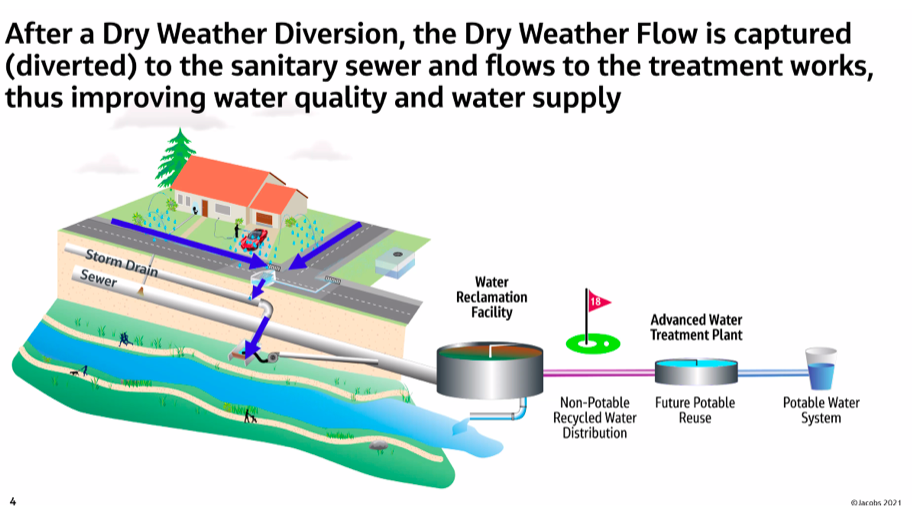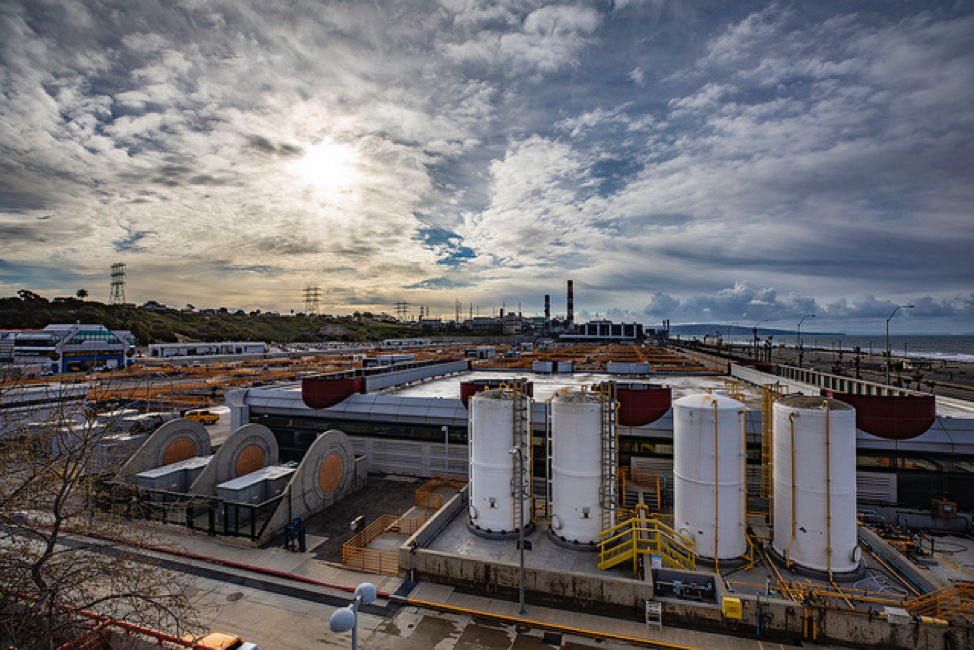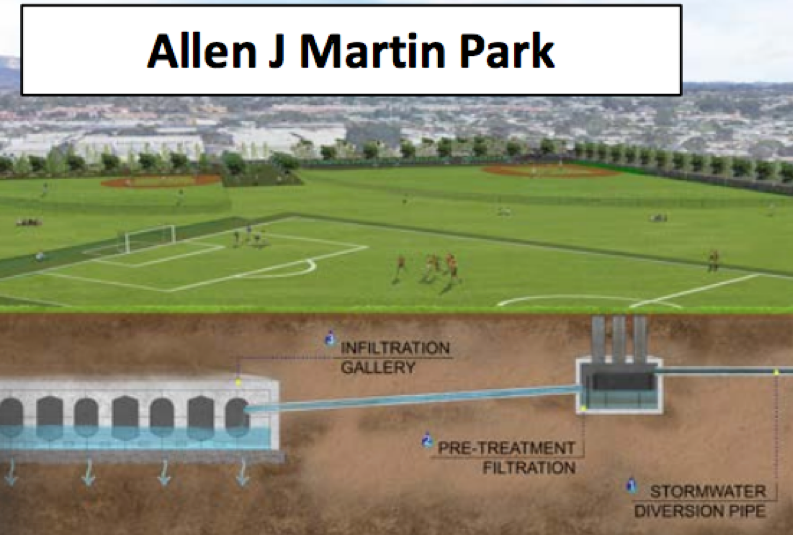Our day-to-day experience with fresh water varies drastically depending on where in the country we live. This week, as I pulled off a highway in Connecticut to avoid the torrential downpour from Hurricane Henri, I thought about my work back home in Los Angeles to adapt to long-term drought. If I had superpowers, one of them might be to redirect the unwelcome floodwaters of the east coast to the water-stressed drylands in the West. If only it were that easy…
Short of Poseidon’s gifts, the closest we can come to drought adaptation in California is to reduce our reliance on water imported from places like the Colorado River Basin and instead soak up the little rain we do get while recycling used water once it leaves our pipes. Desalinating ocean water is another strategy used in many coastal and arid regions, but one that quickly loses its appeal due to energy costs and challenges with the brackish waste it creates. What’s left— stormwater capture, wastewater recycling, and conservation— are the key approaches L.A. is taking to reduce the region’s water portfolio from 85% imported supplies today to 30% by 2035 (Operation NEXT presentation).

The California Aqueduct (State Water Project), built in 1960, transports water from Northern to Southern California across 444 miles. Photo from Water Education Foundation.
There are many types of projects that augment local water supplies, from small-scale green infrastructure like bioswales and cisterns to more centralized projects like spreading grounds for stormwater or treated wastewater, and infrastructure which allows water to infiltrate into groundwater basins for future use. For areas that don’t have groundwater basins that can support infiltration (or for projects that cannot utilize all the water captured on site), it is also possible to divert dry weather flows and stormwater to a nearby wastewater treatment plant, where it could be recycled via advanced treatment. However, combining storm and sewer infrastructure is something many cities across the country are spending millions on to avoid. In these cases, combined sewer overflows or “CSOs” can happen when excess stormwater flows into a community’s wastewater treatment plant and causes raw sewage to spill into nearby waterways— a major issue for places prone to flooding and storm events. However, in Southern California we’re seeing that many sanitary sewer systems actually have the room to take on additional water, thanks to increased capacity from aggressive water conservation in the last 15 years. Projects that can fit into this “stormwater-wastewater nexus” offer opportunities to capture more water supplies (dry weather runoff and possibly rain) and improve water quality to comply with rigorous policies like MS4 permits.

Source: Susan Moisio, Jacobs Engineering: 8/10/21 presentation from “Storm Drains to Sewer” Webinar, hosted by Council for Watershed Health and Southern California Water Coalition.
Our ability to reuse this water for both indoor and outdoor purposes will rely on a new suite of large recycling projects which aim to treat used water that would otherwise flow out to the Pacific Ocean. Operation NEXT, for example, is a partnership between the L.A. Department of Water and Power and L.A. Sanitation and Environment to maximize production of purified recycled water from the Hyperion Water Reclamation Plant, one of the largest sanitation facilities in the world. This process, known as indirect potable reuse, will allow the city to replenish groundwater to be pumped, treated, and moved back into the drinking water system.
Right now, agencies are also working with regulators to forgo groundwater replenishment and directly integrate purified recycled water into the drinking water system, a concept that has failed to garner strong public support in the past thanks to unsavory nicknames like “toilet to tap.” One of the projects I’ve been working on this summer with the Council for Watershed Health is to convene water agencies working on these recycled water projects to coordinate outreach efforts that better align communications to build public support and streamline regulatory processes that favor consistency. Ready or not, the coming years will see huge changes in both our outgoing water flows and the way we use groundwater basins to store and recoup local water supplies.

Hyperion Water Reclamation Plant will be retrofitted with advanced treatment facilities to produce purified recycled water. Photo from LADWP.
While large projects like stormwater diversions and recycled water systems may be the best bet for capturing and recovering the largest quantities of water, their reliance on gray infrastructure raises questions about water quality impacts, energy consumption, concrete usage, community engagement, and more. The final phase of Operation NEXT, for example, will require extensive construction across hundreds of communities to lay miles of new pipeline and build energy-intensive pumping stations to move water to higher elevation. The projects will also have to confront the reality that many Angelinos don’t trust their current tap water, let alone water that was once flushed from strangers’ toilets. Further, these concrete-heavy solutions don’t offer the same type of community benefits that we’re seeing from decentralized projects that offer neighborhoods additional perks like green space, more shade, and places to recreate.
Stormwater diversions, for example, do not require green components and are entirely hidden underground. Further, the public health risks of stormwater diversions and recycled water need to be closely watched. To ensure diversions don’t pose a risk to sewer overflows, smart monitoring will be key to understanding what’s happening in the sewer system and the impact of rainfall events. As purified recycled water is sent to spreading grounds or injected into aquifers, groundwater quality monitoring will also be critical, especially as regulators wrestle to address emerging contaminants of concern like PFAs, which can persist in the environment for decades. If that weren’t enough, projects face a complex road to completion, including considerations of water rights and the cumulative impact on the region’s hydrology (e.g., a reduction of downstream flows to the L.A. River).
Of course, the benefits of these projects may very well outweigh the costs: while energy will be required to pump, treat, and distribute recycled water, energy will also be saved from avoiding traditional conveyance systems, which move water across even larger areas of land. In addition, ratepayers might see cost savings from using a cheaper water source over an imported supply. Finally, the region will be better equipped for future water scarcity— not only will the water portfolio become more diverse, storing water underground instead of reservoirs means less evaporation and less potential for an earthquake-induced disaster.
For large projects that appear gray, there are also opportunities to introduce more community benefits and nature-based strategies. For example, a typical stormwater diversion can be combined with green infrastructure like a wetlands park, capturing more flows by diverting the wetlands’ excess water to a nearby sanitation facility. And as streets are cut apart to lay new pipes for recycled water, agencies can work together on street improvements such as increasing the tree canopy. Workforce development can also become major elements of these projects as potential jobs will be more technical in nature. Finally, there’s a big opportunity to do deeper community engagement for these projects, designing a product that is aligned with community priorities while building trust around drinking water and agency accountability for water quality concerns. As L.A. marches forward to augment its local water supplies, it will become increasingly important to implement projects of all shapes and sizes, delivering much more than just water quantity benefits.

Currently in the concept phase, Allen J Martin Park would be a multi-benefit stormwater capture project with a stormwater diversion pipe. Project concept and image from L.A. County Department of Public Works.

Ryanna Fossum, Western Resource Fellow |Ryanna Fossum is a Master of Environmental Management candidate at the Yale School of the Environment. She is interested in exploring integrated regional watershed management in the urbanized West. Prior to Yale, Ryanna researched California water policy to better engage local elected officials with community-led water resilience efforts.
More recently, she worked on a range of urban design projects to confront public space challenges in New York City. She holds a BA from Oberlin College and majored in Geology and Environmental Studies. See what Ryanna has been up to. | Blog
